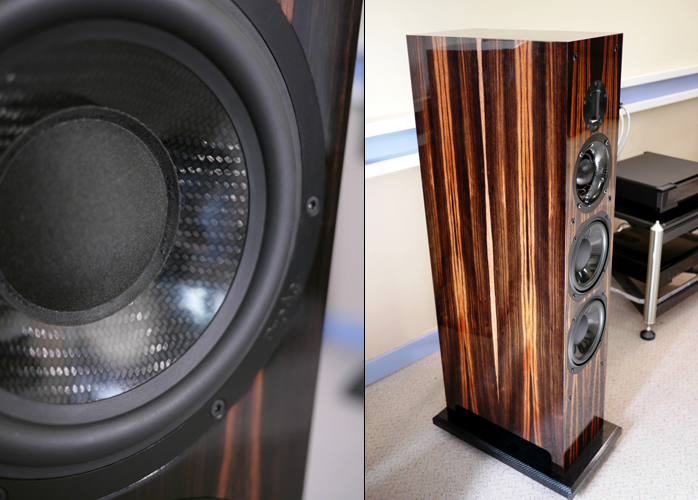This review page is supported in part by the sponsors whose ad banners are displayed below |
 |
 |
|
 |
Reviewer: Bill Armstrong
Financial Interests: click here
Source: Mark Levinson N°390S CD, N°512 SACD [on loan]
Preamp: Mark Levinson N°326S
Power Amplifier: Mark Levinson N°532 [on loan]
Speakers: ATC SCM 50 Anniversary (active)
Cables: JPS Labs SC3 interconnects & speaker cable, JPS Kaptovator power cords.
Stands: Grand Prix Audio Monaco
Powerline conditioning: Ayre L-5xe
Room size: 5m x 8m (WxD), 3m ceiling
Review Component Retail: £18.895/pr in the UK
|
 |
|
 |
Perfectly Natural ProAc began trading in 1979 and since have steadily developed a reputation for crafting impressively balanced products that offer very solid value for money - accomplished ‘all-rounders’ if you like with possibly just a hint of generosity to their house sound. There may be something quintessentially English about the brand because although clearly progressive in their aim to push toward ever loftier sonic goals, there is also a degree of understatement about the whole operation pointing to a quiet self assurance. And that’s the exciting thing about their release of a new flagship range. Like true blue-blooded aristocrats ProAc doesn’t do change for change’s sake.
The Carbon Pro series consists of two models only, the Sixes I’m reviewing here along with the larger Carbon Pro Eight. Cabinet wise both designs have a narrow and deep thing going that most pictures fail to quite capture. Sized at 1185 x 370 x 215mm HxDxW the Sixes will successfully fit into medium-sized listening rooms. The deeply lustrous wooden veneers are mirror perfect and fit and build are Bentleyesque. The subtle graphite-colored back plate including laser-etched serial number is a particularly sexy touch. In the flesh they certainly look and feel the money but their styling does seem a tad conservative in comparison to much of the competition.
|
Sonus Faber Amati Futuras, Focal Scala Utopias and B&W 800s are just three rivals in this approximate price category and although only the Sonus Fabers could be described as pretty, all manage the trick of jumping off the screen or page and lodging themselves in your consciousness. So I wish that the ProAcs shouted a little louder and drew a little more attention.
But they really are rather elegant and will fit more unobtrusively into many domestic environments than the showier alternatives (and the smoky mocha-hued Rosewood on my test pair really was stunning.) I can’t however help wishing that they did look slightly less - well loudspeakerish because the technology employed and the way they sound is anything but old-fashioned.
|
|
|
|
|
|
|
|
|
|
 |
Carbon fiber is obviously the headline act here. Both very light and extremely rigid, its inherent pistonic qualities make it an ideal candidate for moving air at low frequencies without distortion. The material is utilized in twin 6.5-inch bass drivers as well as in the midrange horn surrounding a 3-inch soft-dome driver. It was also selected for the non-detachable plinth after the services of an outside ‘vibration and resonance company’ had been employed to analyze myriad alternatives. Regarding their latest material of choice ProAc’s website states: ‘A/B testing between two identical loudspeakers, one fitted with wooden plinth, polypropylene drive units and plastic midrange horn and one using carbon fiber plinth, bass cones and midrange horn revealed a startling improvement in detail and low coloration’. It’s a far from simple material to work with however, borne out by the fact that just a single midrange horn takes eight hours for ProAc’s in-house team to fabricate. And the choice of ribbon tweeter is also intriguing since the company has implemented them sparingly since their initial appearance in their Future series just over a decade ago. In a brief chat with ProAc’s chairman and chief designer Stewart Tyler, he wished to make it clear that in regard to carbon fiber, ProAc are using proprietary manufacturing techniques that differ from any other loudspeaker manufacturers.
|
|
|
Setting things up couldn’t have been more straightforward. After initial plonking down—sorry, positioning—an afternoon’s listening & nudging saw me settle on a final placement about a further six inches apart and that was it. Toe-in angle was gentle, about 15 degrees. I found that the design enjoyed space to breathe, not so much with regard to rear wall proximity but more concerning a three-foot+ spacing from the sidewalls. Observing this helped the soundstage bloom and also tightened things up dynamically. I listened mostly sans grilles which I had a slight preference for. I can’t discuss burn-in time since the pair I listened to weren’t factory fresh but anecdotal evidence suggests this is one area at least where the speakers are indeed average.
|
 |
All partnering electronics were from Mark Levinson linked by JPS Labs’ cable and supported by Grand Prix Audio. (I must make quick mention of ML’s N°532 400wpc stereo power amplifier which I’ve been fortunate to have on loan. Its juicy midrange, effervescent treble and slightly dry bass proved to be a match made in heaven with the Carbon Sixes.) On paper there is a very useful sensitivity of 90dB and Stewart Tyler mentioned that he’s had good results at the factory with valve amplification rated as low as 25wpc as well as with 40wpc transistor based designs. I don’t doubt him but my own experiences suggested the Sixes were also happily capable of soaking up dubyas like blotting paper. Admittedly I was filling a rather large space (and I do listen at—ahem—‘realistic’ volumes) but certainly these speakers despite the back plate’s guideline of 10-250 watts will handle whatever power you throw at them.
|
 |
|
 |
|